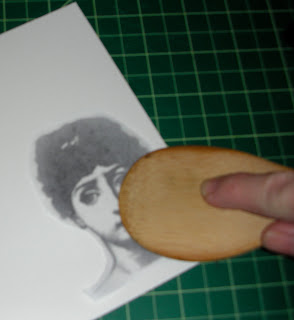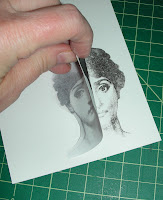The next method I have used to transfer images is by using acrylic gel medium. This method takes awhile to complete because it has to dry for several hours (overnight) before you can fully complete the transfer process.
You will need to gather:
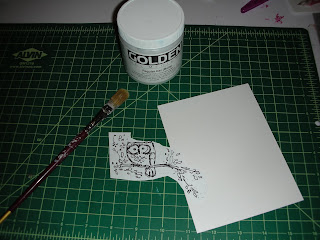
Images - toner based copies or laser jet prints - black and white or color (ink jet prints WILL NOT work)
Acrylic gel medium, a paintbrush, and a piece of paper or sketchbook to transfer onto that can take wet media
Carefully cut out the image, trimming off all the extra paper.
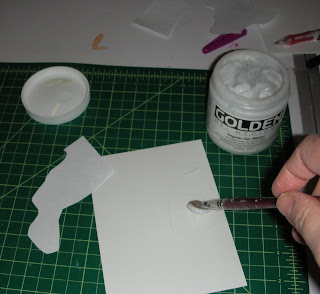
Decide where on the paper you will want the new image transferred.
Brush a solid layer of gel medium onto the paper where you want the transfer to go.
Work quickly, the gel needs to be still wet when you place your image into it.
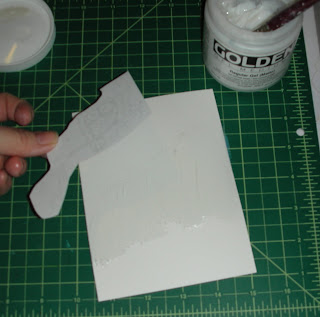
Place your image face down into the wet gel.
If you are using text it is important to remember that the image will be reversed when the process if finished, so manipulate (reverse) your image before transferring.
If you are transferring a large image, it is best to brush gel and stick picture down in sections or the gel will dry before the image can be stuck down completely.
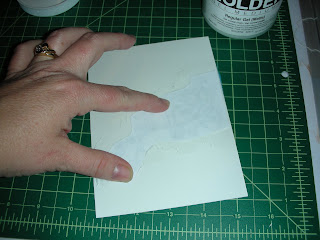
Smooth over the back of the image with your hand, pressing the picture into the gel, removing lumps, creases, and bubbles. Remove any extra gel that squeezes out from under the edge of the image.
Your image needs to sit in the gel until it has dried. Usually three hours works, but I often let them sit overnight.
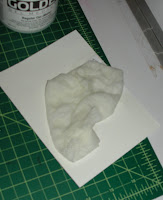
The next day, you will need some paper towels, a sponge, or rag and clean water.
Wet the towel, making sure it is fairly wet.
Place the towel over the image, squishing the towel so water soaks into the paper backing. Allow wet towel to sit on the image for fifteen or twenty minutes.
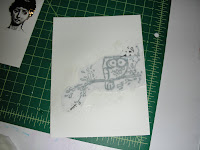
The paper backing will become sheer when the image has soaked under the towel long enough to begin removing the paper from the transferred image.
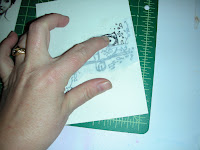
Keeping your finger damp, gently roll the paper backing off of the image. Be sure not to use an alternate tool or your fingernail as a scraper, use only your finger or you will remove the image with the paper.
You may find that the paper does not come off after the first time of soaking under the wet towel. Sometimes you cannot tell there is still paper on the image until after it has dried. Simply return the wet toweling to the image and repeat the paper peeling process until
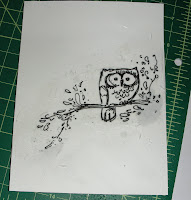
all of the paper has been removed.
You will be able to paint over and on top of the completed transfer with either watercolor or acrylic paint or you can use pencils or other media to alter the image as desired.
If you have a painted background, the background color will show through the image too. This process also works with colored acrylic paint applied as the gel, leaving a transfer on a colored background of paint.
As you can see in the piece of artwork I made last summer using this method to transfer a drawing I created onto multiple square pieces

of paper that I had painted first with liquid acrylics.
Imagine all the possibilities when you can create more than one copy of a drawing.
Happy transferring.

 Well I had a bit of an epiphany - I could use the set and round pans, but empty them of the old paint and fill them with the Grumbacher paint instead. I now had a new putter task, one that was useful and exciting. First I popped all the old pans out. When I did this I discovered they were labeled for color on the bottom, very handy, as I could now match them to my new paints.
Well I had a bit of an epiphany - I could use the set and round pans, but empty them of the old paint and fill them with the Grumbacher paint instead. I now had a new putter task, one that was useful and exciting. First I popped all the old pans out. When I did this I discovered they were labeled for color on the bottom, very handy, as I could now match them to my new paints. 


